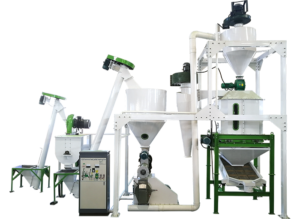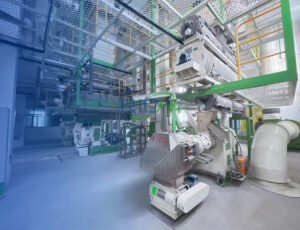
In the constantly evolving realm of global food production, the aquaculture industry has risen to prominence as a pivotal sector, meeting the escalating worldwide demand for seafood. As this industry expands, the imperative for efficient and sustainable fish feed production has become increasingly pronounced. Enter fish feed mill projects, specialized facilities crafted to produce high-quality, nutritionally balanced feed for various aquatic species, thereby safeguarding the long-term sustainability and advancement of the aquaculture sector.
The Emergence and Significance of Aquaculture
Aquaculture, the cultivation of aquatic organisms like fish, shellfish, and aquatic plants, has witnessed remarkable growth in recent decades. This industry now stands as a significant contributor to global food security, furnishing a sustainable source of protein and vital nutrients for a swiftly burgeoning population. The merits of aquaculture encompass:
Increased Food Production: Aquaculture has the capacity to augment, and even surpass, traditional capture fisheries, ensuring a steady supply of seafood to meet escalating demands.
Environmental Sustainability: Prudently managed aquaculture operations can alleviate pressure on wild fish stocks, fostering the conservation of marine ecosystems.
Economic Opportunities: The aquaculture sector generates employment prospects and bolsters the economic progress of coastal and rural communities.
Nutritional Benefits: Seafood offers a rich trove of high-quality protein, essential fatty acids, vitamins, and minerals, contributing to a well-rounded and wholesome diet.
As the aquaculture industry continues its expansion, the demand for high-quality, nutritionally balanced fish feed has emerged as a critical factor in ensuring the sector’s enduring sustainability and profitability.
The Crucial Role of Fish Feed Mill Projects
Fish feed mill projects assume a pivotal position in supporting the growth and evolution of the aquaculture industry. These specialized facilities are tailored to manufacture fish feed meeting the specific nutritional requisites of diverse aquatic species, ensuring optimal growth, health, and productivity. The advantages of investing in fish feed mill projects encompass:
Consistent Feed Quality: Leveraging advanced technologies and stringent quality control measures, fish feed mill projects churn out feed with uniform nutrient profiles, underpinning optimal fish growth and health.
Tailored Formulations: These facilities can concoct feed formulations customized to suit the distinct nutritional demands of varied aquatic species, life stages, and environmental settings.
Efficient Production: Modern fish feed mills are architected for efficient and cost-effective production, harnessing automation and process optimization to maximize output and curtail waste.
Sustainability: Fish feed mill projects can embrace sustainable practices, such as incorporating alternative protein sources, deploying waste reduction strategies, and adopting energy-efficient technologies, thereby championing environmental stewardship within the aquaculture domain.
Economic Opportunities: Investments in fish feed mill projects can spawn job opportunities, invigorate local economies, and contribute to the overall flourishing and development of the aquaculture sector.
Related post: https://www.richipelletmachine.com/floating-fish-feed-mill/
Key Components of a Fish Feed Mill Project
The fruition of a fish feed mill project hinges upon meticulous planning, execution, and integration of various components to ensure efficient and sustainable operations. The key components of a typical fish feed mill project encompass:
Raw Material Handling and Storage: Facilities for receiving, storing, and handling raw materials such as grains, oilseeds, fishmeal, and additives form the cornerstone for ensuring a consistent supply of high-quality ingredients.
Grinding and Mixing: Advanced grinding and mixing equipment are indispensable for attaining the desired particle size and homogeneous distribution of ingredients in the feed formulation.
Extrusion and Pelleting: Extrusion and pelleting systems play a pivotal role in crafting high-quality, durable feed pellets that can endure handling, storage, and transportation sans compromising nutritional value.
Drying and Cooling: Efficient drying and cooling systems are imperative for expunging excess moisture from the feed pellets, thereby ensuring their stability and prolonging their shelf life.
Quality Control and Testing: Comprehensive quality control measures, encompassing laboratory testing and analysis, are indispensable for ensuring that the final feed product conforms to stringent nutritional and safety standards.
Packaging and Storage: Prudent packaging and storage facilities are requisite to uphold the quality and integrity of the feed during transportation and distribution.
Auxiliary Systems: Fish feed mill projects necessitate auxiliary systems such as material handling equipment, dust collection systems, process control systems, and utilities to ensure efficient and safe operations.
Project Management and Support Services: Successful fish feed mill projects often entail collaboration with seasoned engineering and consulting firms, availing expertise in project planning, design, construction, commissioning, and ongoing support.
Factors Influencing Fish Feed Mill Project Success
The success of a fish feed mill project is underpinned by several critical factors, including:
Market Analysis and Demand Forecasting: Undertaking comprehensive market research and demand forecasting is imperative to ensure that the project aligns with the prevailing and future needs of the aquaculture industry.
Raw Material Sourcing and Supply Chain Management: Securing a dependable and cost-effective supply of high-quality raw materials is pivotal for consistent feed production and profitability.
Technology and Automation: Investing in cutting-edge technologies and automation systems can amplify production efficiency, slash labor costs, and enhance product quality and consistency.
Energy Efficiency and Sustainability: Integrating energy-efficient technologies and sustainable practices can mitigate operational costs and curtail the environmental footprint of the fish feed mill project.
Regulatory Compliance: Ensuring compliance with pertinent regulations and standards pertaining to feed safety, quality, and environmental preservation is indispensable for the enduring viability of the project.
Skilled Workforce and Training: Cultivating a skilled and well-trained workforce is imperative for the efficacious operation and upkeep of the fish feed mill facility.
Project Management and Risk Mitigation: Proficient project management, risk assessment, and mitigation strategies are pivotal for ensuring timely completion, cost control, and successful implementation of the fish feed mill project.
Opportunities and Future Outlook
As the global appetite for seafood escalates, the aquaculture industry stands poised for substantial growth, birthing myriad opportunities for fish feed mill projects. The future trajectory for this sector is auspicious, propelled by factors such as:
Increasing Aquaculture Production: The burgeoning global populace and escalating demand for protein-rich sustenance are poised to propel the expansion of aquaculture operations, thereby heightening the demand for high-quality fish feed.
Technological Advancements: Persistent research and development endeavors in realms like feed formulation, ingredient optimization, and production processes are poised to engender more efficient and sustainable fish feed products.
Sustainable Practices: The adoption of sustainable practices, spanning the utilization of alternative protein sources, the adoption of waste reduction strategies, and the embracement of renewable energy sources, will assume greater significance in the fish feed mill industry.
Diversification and Specialization: As the aquaculture industry diversifies into novel species and production systems, there will be an upsurge in the demand for specialized fish feed formulations tailored to precise nutritional exigencies.
International Collaboration and Investment: Augmented international collaboration and investment in the aquaculture sector are poised to propel the inception of new fish feed mill projects, fostering economic growth and technological advancements.
In summation, fish feed mill projects epitomize a pivotal cog in bolstering the growth and sustainability of the aquaculture industry. By investing in these specialized facilities, stakeholders can contribute to satiating the surging global demand for seafood while advocating sustainable practices and fostering economic development.






